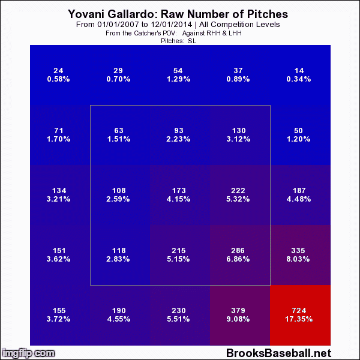 On the surface, it seems the draft pick compensation issue is the main thing keeping the Orioles from inking Gallardo to a multiyear deal. They need another competent starter who throws a lot of innings, and Gallardo is a competent starter who will likely throw a lot of innings. And while his presence would help the rotation, it's up for debate exactly how much of an upgrade he'd be.
On the surface, it seems the draft pick compensation issue is the main thing keeping the Orioles from inking Gallardo to a multiyear deal. They need another competent starter who throws a lot of innings, and Gallardo is a competent starter who will likely throw a lot of innings. And while his presence would help the rotation, it's up for debate exactly how much of an upgrade he'd be.Gallardo, who turns 30 later this month, would rival Ubaldo Jimenez in the O's rotation in terms of career accomplishments. He's no longer the same type of pitcher he was just a few years ago, when he'd average at least nine strikeouts per nine innings and rely on a steady diet of four-seam fastballs, sliders, and curveballs. In 2012, Gallardo posted a strikeout rate of exactly nine; since then, his K/9 has dropped from 7.2, to 6.8, to 5.9 last season. Meanwhile, he's had to focus more on limiting the amount of hard contact against him and trying to keep the ball on the ground.
He still throws fastballs more than 50% of the time, but he now opts for fewer four-seamers and more two-seamers. And while he's seen a relative decline in his fastball velocity, Gallardo has also seen a gradual uptick in his slider velocity the last couple seasons:
Here's one explanation: Gallardo mixes in a cutter, and the difference is sometimes difficult to distinguish. Brooks Baseball labels Gallardo's offerings as sliders. Baseball Savant has him at 209 career cutters thrown (with only two in 2015). FanGraphs has him at 139 total cutters (going back to 2012). Still, the slider and/or the cutter are two of his better performing pitches, along with the curveball.
Gallardo is throwing his slider/cutter more than ever, and he also threw it higher in the strike zone than in any previous season by a decent margin:
Prior to 2015, Gallardo not only focused on keeping the pitch down and away, but also down in general. But last year, he wasn't afraid to keep the pitch in the zone, high or away:
Opposing batters swung more than ever at Gallardo's slider/cutter, but those pitches also generated fewer whiffs. Opponents did have trouble hitting for power against those offerings. One large reason for that: an infield fly ball rate of 41%. It won't be easy to repeat that.
It's unclear whether Gallardo's slider/cutter results are a product of small sample size or suggest anything meaningful. Maybe it's a pitch he's growing more comfortable with and isn't shying away from throwing it in the zone. It seems like Gallardo is a tinkerer who's unafraid to try different things in search of success. Another example of that is his movement to both sides of the rubber the last couple seasons.
Still, it's tough to overlook Gallardo's lack of strikeouts. He can't exactly be considered a question mark, but he's more of a back-end starter in a good rotation (so at least a No. 2 or 3 for the Orioles). By itself, that would be fine. But that depends on the years and dollars he'd command, and it also doesn't factor in the loss of a first-round draft pick. Gallardo's price is clearly dropping, though, which is why the Orioles are hovering.
Perhaps the Orioles would be better off keeping their first-round draft pick and going with a revolving door of Vance Worley, Odrisamer Despaigne, Mike Wright, and Tyler Wilson as the fifth starter. That way, they could ride the hot hand and also maintain some flexibility (though Worley is out of options). But that's also something that occasionally sounds better in theory than in practice, and it doesn't account for an injury to any of the O's other starting pitchers. Gallardo would make the O's a little bit better, but it would come at a steep price.
The Orioles' major league team needs some help. Their farm system needs even more help. No one said this would be easy.
Photo via Keith Allison





